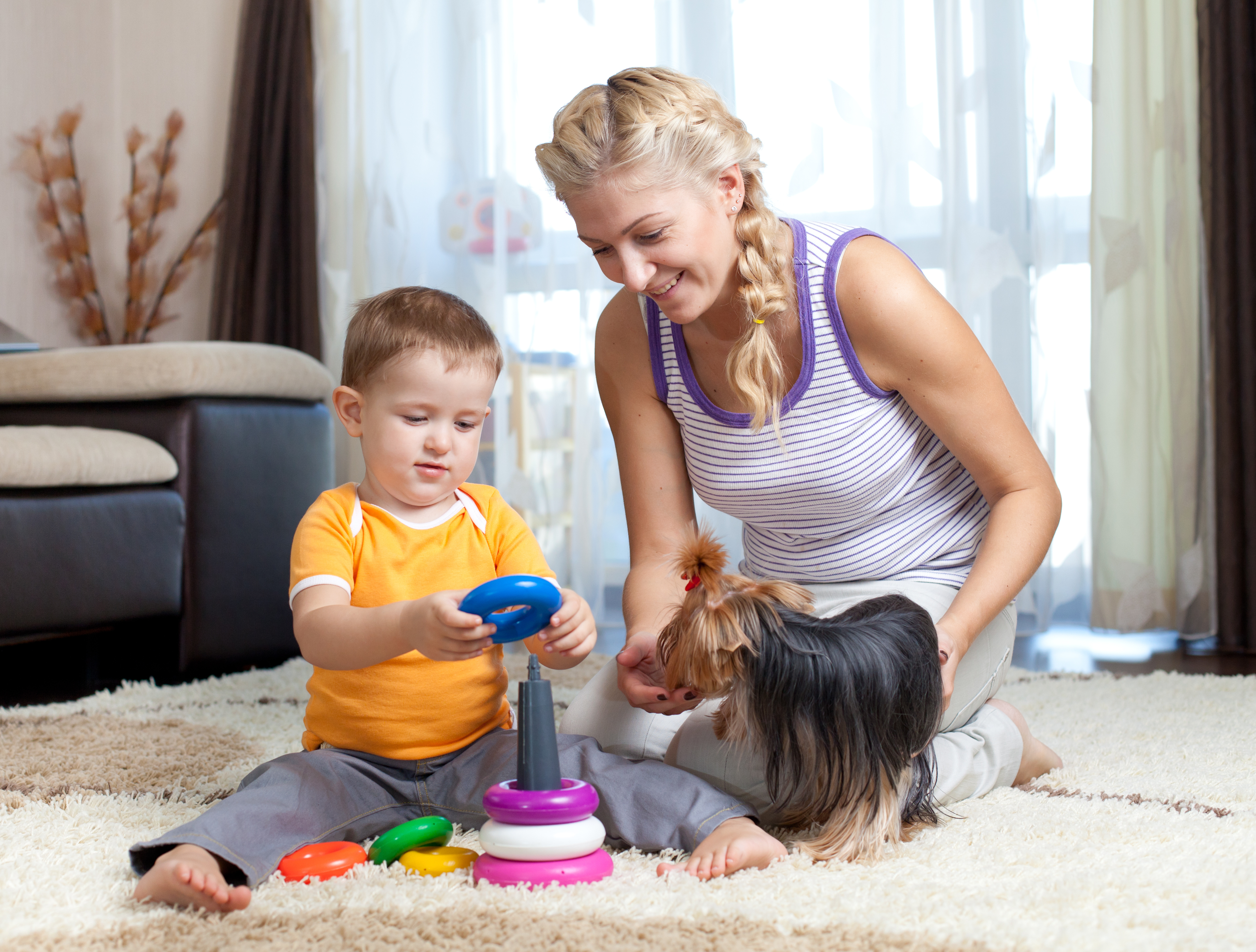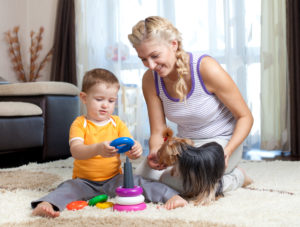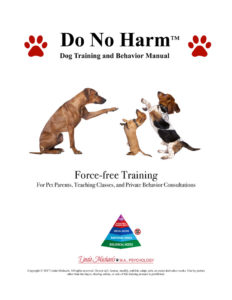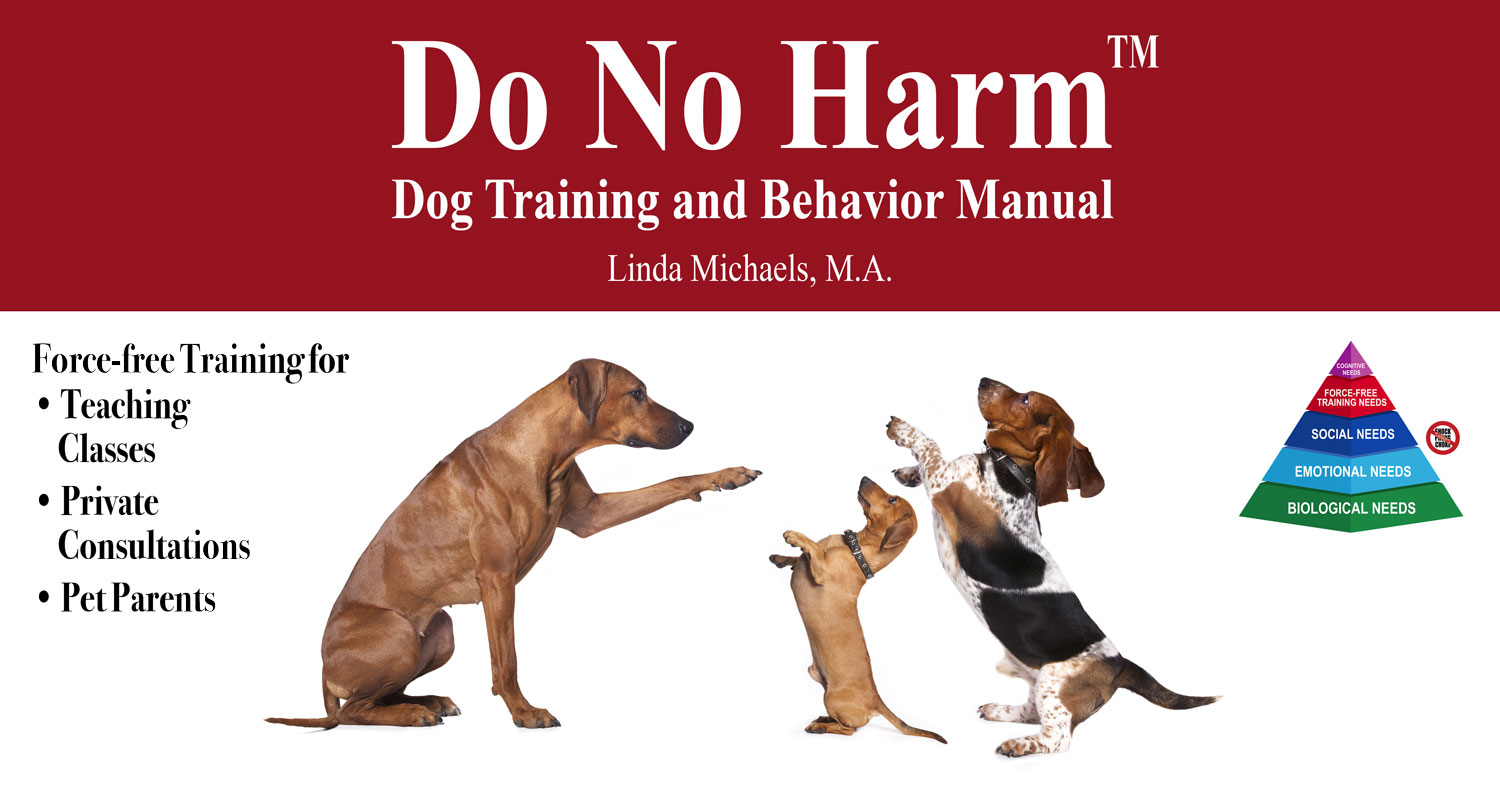This is an excerpt from Linda’s book, Do No Harm™ Dog Training and Behavior Manual, available to download here.
Are you planning to bring a puppy or new dog into a family with an infant or toddler? Are you concerned about protecting your newborn but still want one big, happy family? Many dogs accept a new baby without any problems; however, some don’t, and some need a lot of help. This primer is designed to help you prevent potential problems and encourage you to be well-prepared to care for both dog and baby.
As responsible baby and pet parents, it’s your job to protect your baby from your dog, and to protect your dog from your baby!
Safety first is the cardinal rule. Many online posts show seriously unsafe interactions between babies, young children, and the family dog. Children are the population most frequently bitten by dogs, so you’ll need to take the relationship between your child and your dog very seriously.
Your baby’s and dog’s relationship will change as they grow. Friendly puppies often react differently to your children at each stage of the puppy’s development and at each stage of the child’s development. Most parents see a change in the behavior of the dog when the child begins to crawl, toddle, and then run.
Ultra-close supervision is the responsibility of the parents, not the responsibility of the dog or the toddler. Keep your child and your dog safe and prevent harassment of your dog by your naturally curious child. It’s up to you, the child’s parent and pet parent, to draw clear physical boundaries and make the rules.
Your child does not have the cognitive ability to understand that
- The dog can bite, and what the implications of a bite would be to the child, the family, and the dog.
- The child can hurt and/or frighten the dog. Your child does not have the ability to understand that the dog is not a moving plush toy, that your dog can experience fear or be injured.
It has been shown through research of a child’s normal development that it’s not until approximately the age of 5 that the child can process the fact that the dog can hurt them, and that they can hurt the dog. Ideally, parents ought to add a dog to the family after the children have reached the age of five years old…but often that’s not the way life unfolds.
Never leave a baby or child alone with a dog. Make certain the dog NEVER has access to the baby without an adult present. No dog should be trusted with a small child… and no small child should be trusted with a dog!
Any dog will bite if sufficiently provoked. Your dog may not recognize your newborn as a human member of the family. To keep things under control, consider making the inside of the nursery off-limits to your dog. Secure it.
Seek to achieve safety and harmony through proper preparation and careful management until your child is old enough to have a relationship with your dog based upon mutual respect.
Here are some guidelines to help you prevent predictable problems.
Prepare your dog months in advance for the arrival of a baby into the home.
- Assess
- Ultra-socialize
- Train
- Desensitize your dog before you bring your baby home if possible.
- You need your dog to be
- Healthy
- Highly socialized
- Well-trained
- Visit your veterinarian to get a wellness exam for your spayed or neutered dog. Rule out possible medical, organic, or pain causes of unwanted behavior through a complete wellness exam and update titers or vaccinations.
Evaluate the nutritional needs of your dog because diet affects behavior. You want to be sure you’re feeding your dog a truly healthful, species-specific diet.
Transitioning. Begin to foster independence in your dog and, if practical, slowly transition primary dog care-taking duties to your partner before you bring the baby home.
Habituate and desensitize your dog to new baby sounds, gadgets, smells, and various baby routines by role-playing activities such as diaper changing and stroller walks with a doll. Dogs love routines.
Everything associated with the baby should become the new normal as opposed to surprising or anxiety-provoking. You don’t want your dog to be anxious about having a baby join the family. Check out Preparing Fido, a CD of crying, grunting, bathing, and giggling baby sounds, from the Humane Society of the United States.
Personality profile. What is your dog’s background and history? Assess your dog’s behavior toward infants, toddlers, strangers, as well as reactions to novel items, smells, and situations. Does your dog have small-animal predatory tendencies, resource-guarding behaviors, startle phobia, or fear responses? If so, call a professional for an assessment and treatment.
Address training and behavior issues before the baby arrives. Basic Manners requirements are:
- Name Response
- Sit
- Down
- Wait/Stay
- Come
- Calm Leash-walking
Practice using voice instructions with your dog so that your hands are free to care for your baby. Train-out the behaviors you don’t want. Don’t play aggressive games with your dog. Private consultations, distraction-free training, and practice in your home can provide the best results.
Create a Dog Zone Sanctuary and a Baby Zone. Enclose gated areas to keep dog and baby separated so both you and your dog can relax, and your defenseless baby is safe. Your dog needs a safe place where she/he can relax away from your child as well. Always keep your dog with you or in a secured Dog Zone.
Learn to read your dog’s body language so you can tell if your dog is experiencing stress around your baby. Watch out for avoidance or fixation. Listen for vocalizations and notice the difference between how your dog looks when she’s happy versus when stressed.
Exercise. Be sure to provide your dog with lots of aerobic exercise. Employ a dog walker if your dog needs more exercise or fun than you can now comfortably provide! Try to provide running, swimming, or doggie play-dates at least twice a week for active dogs.
Socialization to infants and children. After taking the Desensitization steps above and under 100% close supervision, take your people-friendly dog to observe children at play. Encourage friends with infants to visit in order to slowly and safely accustom your dog to the presence of babies in the home. Reward your dog with treats and soft praise for remaining calm in order to develop positive associations between your dog and babies.
Introduce your dog to your baby in a slow, gradual fashion. Make it a non-event. When coming home from the hospital, have Mommy come into the house alone and calmly greet the dog. Then put the dog on leash and ask for a Sit or Down. Have your partner come in with the baby and either retreat to another room and save introductions for later, or if your dog looks relaxed, walk your dog calmly and slowly toward the baby and let him sniff the baby’s toes—not the face. Ideally, your dog will not be overly interested in the baby and then treat your baby with indifference, which is fine. Help your dog experience the arrival of the baby as a good thing.
According to veterinarian Dr. Nicholas Dodman, “Share your attention with the dog when the baby is around.” This will help endear your baby to your dog and prevent “sibling” rivalry.
When to seek professional help. Generally, dogs that display any aggressive behaviors are not appropriate for families with children. These problems need IMMEDIATE intervention. Seek professional help anytime you have concerns about:
- Interactions between your dog and your child
- Your dog and other family members
- Growling or other displays of aggression
- Guarding behaviors of items or people
- Sudden changes in your dog’s behavior
- Conflict between dogs in the home
These suggestions will help prevent stress to your dog, will provide plenty of attention through reward-based training, and will help him or her be a good dog around the baby. Dogs love routines and your dog will “thank you” for providing new routines for her or him to follow.
Renowned specialist, Colleen Pelar’s, Living with Kids and Dogs may be found at: www.livingwithkidsanddogs.com. Her website is filled with helpful articles, an advice column and more. You can attend a Dogs and Babies seminar or arrange for a private consultation in your home with a local behavior consultant. And don’t forget www.familypaws.com.
Get your FREE DOWNLOAD of American Humane Association’s new, Pet Meets Baby.
The American Veterinary Medical Association has a must-read online brochure: What You Should Know About Dog Bite Prevention.
Learn more about pet parent problem-solving, teaching classes, and private consultations in the Do No Harm Dog Training Manual.
The Do No Harm™ Dog Training Manual was designed as my own personal guide for teaching basic manners classes, and evolved into a reference manual for my private behavior consultations. Created as a practical guide for either or both training formats, it is also helpful for pet parents who want an inside look at dog training and behavior, as well as for those who seek force-free solutions for specific problems. Written with love for the “heartbeats at our feet”. You can purchase and download the PDF ebook dog training manual here.
Linda Michaels, “Dog Psychologist,” M.A./Psychology a Top Ten Rated U.S. Dog Trainer — Del Mar Dog Training, may be reached at 858.259.WOOF (9663) or by email: LindaPositively@gmail.com for private manners/obedience instruction and behavioral consultations near Del Mar and the San Diego Coast. Please visit us at DogPsychologistOnCall.com All rights reserved.



